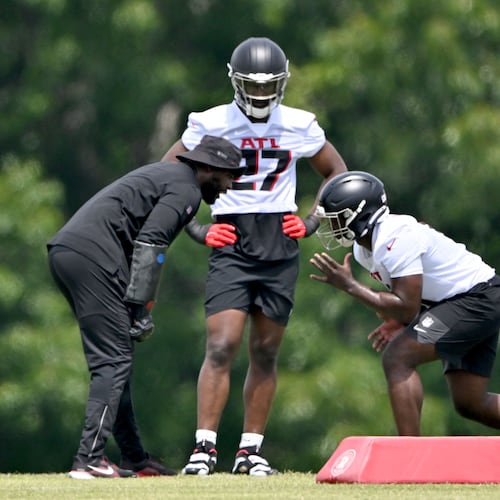Hayden Hurst is at his best when he’s lined up against a linebacker or an undersized defensive back. From there, it’s about sprinting vertically downfield and positioning his body to win those individual matchups.
Given the options the Falcons have at receiver -- Julio Jones and Calvin Ridley -- Hurst should have plenty of opportunities to catch passes down the field in single coverage. If Hurst draws man coverage or sees a vacated hole in the zone thanks to the team’s other weapons, there’s a great chance quarterback Matt Ryan will be looking his way a lot in 2020.
And if extended those pass-catching opportunities, Hurst believes he can makes defenses pay with the attributes he brings to the tight end position.
“It starts with my speed,” Hurst said. “A lot of guys don’t understand how quickly I can move around. I think I’m able to get on those safeties pretty quick. With the way that Matt throws the ball, I’m able to use my size to box those guys out and make those big boy catches.
“I’ve been doing that since college really well. I did it in Baltimore a little bit. But I think that’s one of the things I will do really well this year. It’s just the way that I move guys off the line, use my size and use my speed.”
Hurst, who was acquired by the Falcons via a trade with the Ravens this offseason, is replacing tight end Austin Hooper, who left for Cleveland in free agency. Hooper does have big shoes to fill, considering Hooper posted the best season of his career, with 787 yards and six touchdowns while missing three games because of injury.
Hurst, conversely, is in a position to assume a No. 1 tight end role for the first time in his career. Selected by Baltimore in the first round of the 2018 NFL draft, Hurst suffered a stress fracture as a rookie that set him back in terms of playing time. Mark Andrews went on to secure the starting tight end job in Baltimore and never looked back, leaving Hurst in a backup role.
With the Falcons, Hurst is sitting alone at the top of the tight end depth chart. Hurst’s ability to hit defenses vertically was intriguing when the Falcons went searching for a replacement for Hooper.
“The one thing when you watch Hayden from college and even at Baltimore is his ability to run seam routes,” Quinn said. “There’s a certain knack and technique that goes along with that. How do you work a guy out a seam and break back in to go catch passes? He’s got a really-big catch radius where he can go up and grab it. Those are things, with his speed, he’s really good at running vertical routes.”
Ryan echoed this sentiment, saying that Hurst, with his 6-foot-4 and 265-pound frame, offers something unique to the position as a pass-catching option.
“I’m probably most excited about his athleticism,” Ryan said. “He’s extremely fast, very good change of direction. He’s big and strong. He’s everything you would want in a tight end. So I think he’s going to be a nice piece of the puzzle for us.
“He’s a different guy from a tight end standpoint than I’ve played with. He’s got a different skill set than Austin Hooper or Tony Gonzalez. He’s unique in that way. I’m excited to kind of utilize some of the things that he does and add to our scheme.”
One example of Hurst’s expertise when it comes to running the seam route came late during last season’s AFC divisional-round game between Baltimore and Tennessee, albeit late in a Titans victory. At the Titans’ 15-yard line, Hurst ran up the seam with safety Kenny Vaccaro draped on him, leaving a tight window. Quarterback Lamar Jackson put the ball high in the air and allowed his tall tight end to adjust his body position before jumping up to snag the pass for a touchdown.
The offense in Baltimore, however, revolved around Jackson and the team’s rushing attack. With the Falcons, Hurst described it as more “pass heavy,” with a scheme that he said is similar to what he ran in college at South Carolina. With the Gamecocks, Hurst was targeted a lot as he caught 92 passes during his sophomore and junior seasons.
Late in a 2016 game against Florida, in a play beginning at South Carolina’s 34-yard line, Hurst ran a seam route and caught the pass in stride at the Gators’ 45. He shrugged off one defender at the 39-yard line and took contact from another at the 36. He carried that second defender an additional 17 yards before he was tackled at the 19-yard line, which was good for a 47-yard reception.
That’s the type of play Hurst hopes to see more of with his new team.
“It caters to what I did in college a little bit better,” Hurst said. “I think I’m going to be able to use my size and my speed and help find these voids in the zones, help (Julio Jones) get open and get the attention of the safeties with my speed up the field.”
About the Author
Keep Reading
The Latest
Featured

